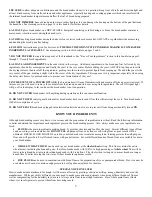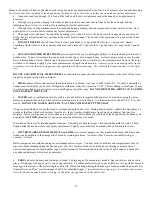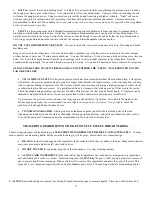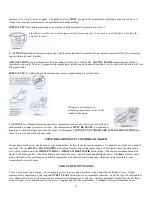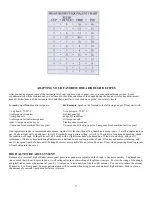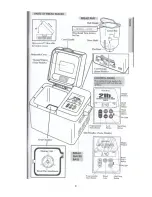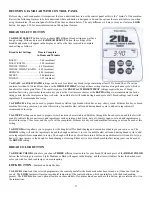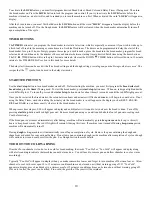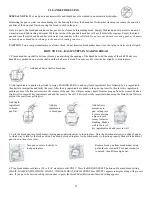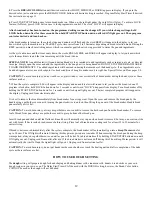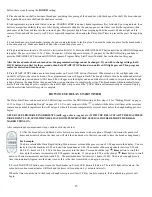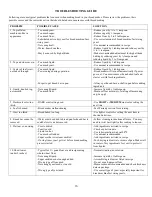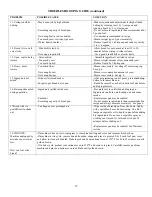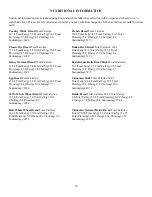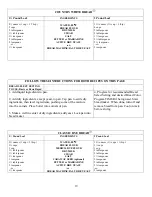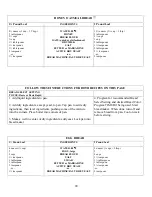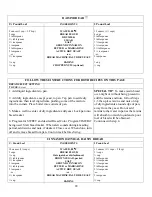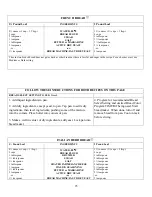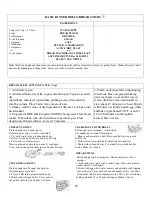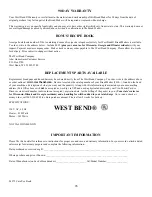
16
TROUBLESHOOTING GUIDE
Following are some typical problems that can occur when making bread in your bread maker. Please review the problems, their
possible causes and the corrective action that should be taken to ensure successful bread making.
PROBLEM POSSIBLE
CAUSE
SOLUTION
1. Top inflated,
mushroom-like in
appearance.
-Too much yeast.
-Too much sugar.
-Too much flour.
-Substituted active dry yeast for bread machine/fast-
rising yeast.
-Not enough salt.
-Warm, humid weather.
-May be caused by high altitude.
-Reduce yeast by ¼ to ½ teaspoon.
-Reduce sugar by 1 teaspoon.
-Reduce flour by 2 to 3 tablespoons.
-Use correct amount of bread machine/fast-rising
yeast.
-Use amount recommended in recipe.
-Reduce liquid by 1 tablespoon and reduce yeast by
¼ to ½ teaspoon.
-Make recommended adjustment for high altitude
baking by reducing yeast by ¼ teaspoon and
reducing liquid by 2 to 3 teaspoons.
2. Top and sides cave in -Too much liquid.
-Too much yeast.
-Reduce liquid by 1 tablespoon.
-Use amount recommended in recipe.
3. Center of loaf is raw,
not baked through.
-Too much liquid.
-Power outage during operation.
-Forgot to put knead bar in pan.
-Reduce liquid by 1 tablespoon.
-Bread maker will turn off automatically if power
goes out. You must remove the unbaked loaf and
start over with fresh ingredients.
-Always put knead bar on shaft in pan before adding
ingredients.
4. Gnarly, knotted top,
not smooth.
-Not enough liquid.
-Too much flour.
-Increase liquid by 1 tablespoon.
-Measure flour accurately, leveling off measuring
cup. See pg.5.
5. Dark crust color/too
thick.
-DARK crust setting used.
-Use
LIGHT
or
MEDIUM
crust color setting the
next time.
6. Loaf is burned.
-Bread maker malfunctioning.
-See Warranty section for servicing.
7. Crust too thick.
-Bread baked too long.
-Use lighter crust color setting the next time to
shorten bake time.
8. Knead bar cannot be
removed.
-Water must be added to bread pan for knead bar to
soak before it can be removed.
-Follow cleaning instructions after use. You may
need to twist bar slightly after soaking to loosen.
9. Flat loaves, no rising
-Yeast omitted.
-Yeast too old.
-Liquid too hot.
-Too much salt added.
-Sugar or other sweetener omitted.
-If using timer, yeast got wet before bread making
process started.
-Add ingredients as listed in recipe
-Check expiration date.
-Use lukewarm liquid, about 80
°
F.
-Use amount recommended.
-Add ingredients as listed in recipe.
-Push dry ingredients into corners of pan. Make well
in center of dry ingredients for yeast to protect it
from liquids.
10. Short loaves.
(under 5 inches)
-Typical for 1½ pound loaves and recipes using
whole-wheat flour.
-Not enough liquid.
-Sugar omitted or not enough added.
-Wrong type of flour used.
-Not enough yeast used or too old.
-Wrong type of yeast used.
-Normal situation, no solution.
-Increase liquid by 1 tablespoon.
-Assemble ingredients as listed in recipe.
-Do not use all-purpose flour.
-Measure amount recommended and check freshness
date on package.
-Use correct type of yeast, especially important for
bread machine/fast rising yeasts.
Summary of Contents for L4972T
Page 9: ...8...


